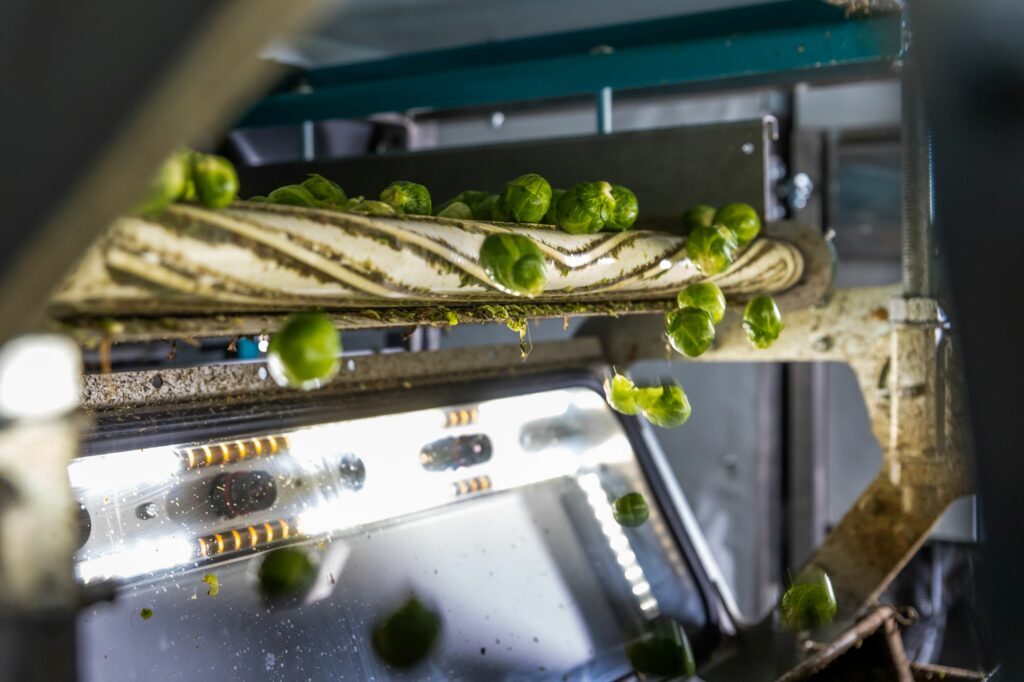can anomaly detection be beneficial to agriculture & food processing?

About
Company
VinteccLocation
BelgiumCompetences
machine vision
computer vision
anomaly detection
quality inspection
smart food processing
can anomaly detection with machine vision be beneficial to agriculture & food processing?
The agriculture and food processing industry faces unique challenges, especially as consumer demand for high-quality, safe products grows and the need for efficiency becomes more urgent. One technology transforming this sector is anomaly detection through machine vision. Whether you're a large-scale food processor or an agricultural producer, adopting machine vision for anomaly detection can significantly improve quality, reduce waste, and optimize operations.
1. The big picture: Increasing pressure on quality and efficiency
In the agriculture and food processing sector, companies like Agristo and Poppies Bakeries process thousands of tons of fresh produce daily. From sorting vegetables to inspecting macarons, there’s an immense pressure to meet high standards for quality and food safety. With labor costs rising and consumer expectations for flawless products ever-growing, traditional methods of manual inspection are struggling to keep up.
In this environment, machine vision-based anomaly detection offers a scalable, high-tech solution that can transform how companies manage quality control and streamline their operations.

2. The challenge: Inconsistent quality and high waste
The food sector is inherently variable. Fruits and vegetables are subject to changes in size, color, and shape, often influenced by environmental factors. While cookies or other bakery products have to have the correct shape and no defects. Manual sorting and inspection processes are not only time-consuming but also inconsistent. Even the most experienced human inspectors can miss subtle defects, leading to:
- Inconsistent quality: Some defects, such as bruises, spots, or misshapen produce, may go unnoticed, resulting in subpar products reaching consumers.
- High waste: Without precise detection, processors often reject large quantities of good produce that don’t meet uniform standards, leading to unnecessary food waste.
- Labor costs: Sorting and grading require significant manpower, which drives up operational costs, especially when scaling up production.
To stay competitive, agricultural and food processing companies need to find a more efficient and reliable solution to manage quality control at scale.

3. The solution: Anomaly detection with machine vision
Machine vision with anomaly detection is a game-changing technology for the agriculture and food processing sector. It uses advanced image processing algorithms to inspect, sort, and grade produce in real-time, identifying even the smallest of anomalies that could indicate defects.
Here’s how it works:
- Real-time inspection: Machine vision systems capture high-resolution images of produce on the processing line and use algorithms to detect deviations from predefined standards. These anomalies can include size, shape, color, bruising, or contamination.
- Non-destructive testing: Unlike traditional methods that may involve manual handling, machine vision systems analyze each product without damaging or slowing down the process.
- Customizable detection parameters: Companies can set specific parameters to define what constitutes an anomaly for their products. For example, a food processor might want to reject tomatoes or Brussels sprouts with bruises larger than a specific threshold or potatoes with more than a few visible blemishes.
This technology brings a level of precision and speed that manual inspection simply cannot match. Here’s why it’s so beneficial for agricultural and food processing operations.

4. Benefits of machine vision anomaly detection:
- Improved product quality: Machine vision can catch even the smallest flaws, from discoloration to texture issues, ensuring that only the best-quality produce makes it through the processing line. This leads to a higher quality end product, enhancing brand reputation and consumer trust.
- Reduced waste: By precisely identifying anomalies, machine vision systems allow processors to discard only genuinely defective products, reducing unnecessary waste. For example, a fruit may be misshapen but still perfectly edible—machine vision can distinguish these cases, preventing the over-rejection of good produce.
- Increased efficiency: With machine vision, inspections can be done faster and more accurately than with human labor. This results in higher throughput while maintaining strict quality standards, allowing companies to scale production without the need for significant increases in labor.
- Lower labor costs: Automating the inspection process with machine vision reduces reliance on manual labor for sorting and grading, leading to long-term savings on labor costs. Staff can be reallocated to more value-added tasks, improving overall operational efficiency.
- Traceability and data insights: Machine vision systems not only detect anomalies but also collect valuable data on the nature and frequency of defects. This information can be used to improve processes, optimize farming methods, or even adjust supply chain logistics, contributing to long-term improvements in yield and quality.

5. The results: A transformative impact on agriculture and food processing
For companies like Poppies Bakeries and Agristo, which handle large quantities of ingredients or fresh produce, anomaly detection with machine vision can revolutionize operations. Here’s what they stand to gain:
- Up to 30% reduction in waste: By accurately identifying usable produce, machine vision can significantly cut down on food waste, saving resources and improving sustainability.
- 50% faster quality inspections: Automated inspection reduces bottlenecks in the production line, allowing companies to process more product in less time.
- Enhanced consumer satisfaction: With fewer defective products reaching store shelves, companies see fewer returns and complaints, boosting brand loyalty and customer satisfaction.

Why is this important for you
In the highly competitive and fast-moving world of agriculture and food processing, anomaly detection with machine vision is more than just a trend—it’s a necessity. By improving accuracy, reducing waste, and cutting costs, this technology offers a clear path forward for companies looking to optimize operations and deliver consistently high-quality products.
If you're in the agricultural or food processing industry, the question isn't whether machine vision can benefit you—it's how soon you can implement it to stay ahead of the curve.

